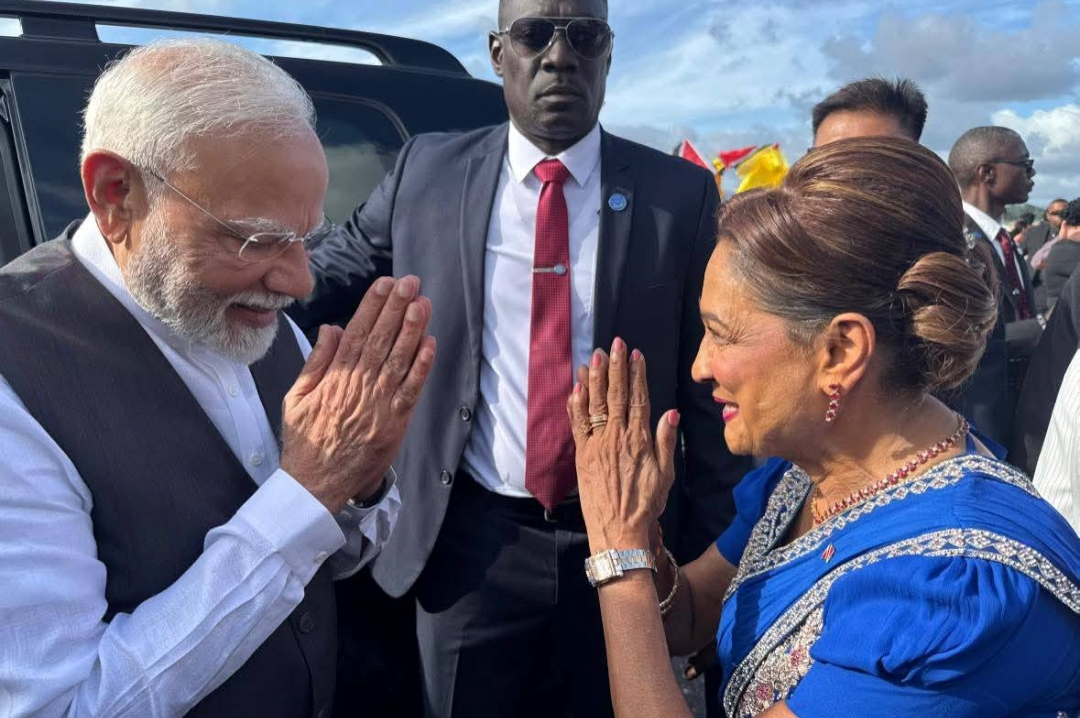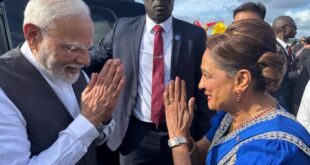In defiance of the rapid community spread of Covid-19, Prime Minister Dr Keith Rowley, kept the promise he made on Emancipation Day 2019 to unveil T&T’s first emancipation monument—the only live public event on Emancipation Day 2020.
Like many thousands of other Trinbagonians, I missed the commemorative spectacles of the longest day in the Pan-African Festival’s calendar. But instead of regrets, the occasion motivated me to reexamine the intellectual underpinnings and contradictions of Britain’s 1833 Abolition of Slavery Act.

(via ESC)
Many already know that the Abolition of Slavery Act did not emancipate anyone. Less known is that England did not legislate for emancipation in 1838; it was the colonies that did so.
Interestingly, the imperial law of 1833 was not named The Emancipation Act, as most persons continue to refer to it. Not once did the Act mention the word emancipation. The words used were ‘manumit’ and ‘manumission’, as had been used in English statutes on slaves and slavery since the fifteenth century.
Manumit; emancipate: ‘same difference’, one might say. Actually, there is an important difference.
Since the seventeenth century, the term ‘emancipation’ in English law was used almost exclusively in regard to religious toleration. As late as 1829, for example, there was the Catholic Emancipation Act granting Irish and English Catholics the same rights as Protestants under the Toleration Act of 1689.
White British abolitionists to a man (and woman) consistently rejected emancipation for enslaved Africans right down to 1828, while pressing for the abolition of the slave trade and amelioration of slavery.
On the other hand, black British abolitionists, most notably Ottobah Cugoano, writing in the 1780s, demanded both emancipation and the abolition of the slave.

The Abolition of Slavery Act solemnly declared that from August 1, 1834, chattel slavery ‘shall be and is hereby utterly and forever, abolished’. It promised enslaved Africans that they would be ‘free and discharged of and from all manner of slavery’.
What was actually delivered was a deceitful bait-and-switch: instead of emancipation, enslaved Africans were inflicted with ‘apprenticeship’—a catchword that had no substantive meaning, because the ‘apprentices’ were not put into any situation to learn new skills.
Apprenticeship was not a transition to freedom—rather, it was a negation of freedom. It was a transition from the whip of the slave master to the whip of the magistrate; it was a transition from proprietary slavery to colonial racism.
Above all, it was primarily compensation in kind (labour). The imperial government calculated the value of the six years of apprenticeship at some £15m, in addition to the public grant of £20m. But when the anticipated indentureship of freed children was included, Apprentice labour was worth a whopping £27m.
Evidence deduced on the working of Apprenticeship after two years, showed that it was not just ‘slavery under a different name’, but really, a worse form of slavery. The power to administer punishment shifted from the slave master to stipendiary magistrates. But most magistrates were beholden to wealthy slave masters.

In the first 22 months, magistrates ordered 933,254 lashes for ‘apprentices’. The Marquess of Sligo, Governor of Jamaica during this time, testified that a Jamaican man received 517 lashes ‘on account of a trifling theft’.
Prior to apprenticeship, such inhumane beatings were administered to persons accused of insurrection or similar extreme acts of resistance.
Sligo affirmed that the brutal cat-o’-nine tails ‘was in great demand’. Contrary to expectation, the Jamaicans did not retire the more dreaded cart whip. Women were mercilessly flogged and subjected to the treadmill from which horrifying stories of torture rivalled the worse terrors of the pre-apprenticeship period; and chain gangs were common.
During the Parliamentary debates on the Slavery Abolition Amendment bill in early 1838, there was an ontological shift in legal jargon from manumission to emancipation, which further evidences that the original Abolition Act was indeed an extension of chattel slavery.
There were new petitions calling unequivocally for the ‘emancipation of the negroes’; MPs referred ad nauseam to ‘total emancipation of the negro’; ‘emancipation of the slaves’; and ‘immediate emancipation’—all of which could be reduced to a simple equation: emancipation equals freedom equals abolition of apprenticeship.

Biohó, was born into a royal family in the Kongo kingdom before being captured and sold into slavery.
He established the maroon community of San Basilio de Palenque in the 16th century.
The pro-abolitionist MPs of 1838 cited three models of emancipation: Antigua (which avoided apprenticeship), Bolivia and Haiti. By 1 August 1834, Antigua had legislated a package of ‘Masters and Servants’ ordinances that effectively nullified the benefits of immediate emancipation.
These laws became the model of institutional racism that would define the post-slavery Anglophone Caribbean.
Article 11 (5) of the Bolivian Constitution of 1827 gave all slaves ‘the right of freedom’, while circumscribing their freedom of movement: ‘they cannot quit the residence of their former masters, except in the manner which shall be determined by a special law’.
In actual fact, Africans in Bolivia were emancipated only in 1851—after decades of debate on the constitution.
Jean Jacques Dessalines’ Haitian Constitution of 1805 was the only republican constitution in the western hemisphere to abolish slavery and implement equality before the twentieth century.
Article 2 of the Constitution of 1805 stated unambiguously: ‘Slavery is forever abolished’. Article 3 abolished racism and class privilege by affirming ‘equality in the eyes of the law is uncontestably acknowledged’.

Prior to 1838, legal documents pertaining to English colonies studiously avoided the words ‘emancipate’ and ‘emancipation’ of Africans, except in reference to the emancipation of African-Europeans or Free Coloureds in 1831. Yet, thousands of enslaved Africans had been manumitted in various ways before the Abolition Act of 1833.
Under the Spanish system of coartación, enslaved persons could manumit themselves, through a process of instalment payments. Those freed by this process were called coartados in Cuba, the equivalent of manumisos or libertos in Venezuela, and the equivalent of the first generation of ‘gens de couleurs’ in French colonies and the ‘free-coloured’ caste in English colonies.
Spanish law was maintained in Trinidad up to 1844. When Britain issued her first imperial slave code, known as the Amelioration Order-in-Council (March, 1824), the Spanish principle of manumiso via coartación was a cornerstone of the amelioration experiment.
Between 1st January 1821 and 31st December 1827, over 965 enslaved persons in Trinidad gained their freedom gratuitously or by self-purchase. Of the 576 who bought their freedom, the total cost was £37,466. The equivalent value today is a staggering £4,357,925 (using Historical Conversion of Currency online).

This was their own money earned from huckstering, Sunday market vending, and commissions from self-hiring and other activities. From 1824 they could open accounts in the new Savings Bank, set up exclusively for them.
Thousands of enslaved Africans in Trinidad gained their freedom through these methods, prior to the abolition of apprenticeship in 1838.
Many other Africans in Trinidad were emancipated before Emancipation Day 1838. Before the abolition of the British slave trade, a group of Mandinka Muslims led by Imam Jonas (Yunus) Muhammad Bath, purchased their freedom and established a jamaat or Muslim community in Port of Spain. These Africans were the first free Muslims in Trinidad.
Bath Street in Laventille is a reminder of the location of the Mosque. Bath was brought to Trinidad in a slave ship in 1804 and was purchased by the government to assist in the construction of Fort George.
In 1835, Attorney General Henry Fuller recalled in a letter to Governor Hill that Bath was a ‘Prince’ and ‘High Priest’ (Imam) in Africa. Even more amazing, Fuller said: ‘Jonas Bath was and still is considered to be a Magistrate and exercises the power of one in all civil matters between his own countrymen’. This was the first and only recorded case of Sharia law in the Caribbean.

Britain’s Mutiny Act of 1807 manumitted the 10,000 slave-soldiers of the twelve West India Regiments, but they were compelled to serve out the rest of the Napoleonic War.
After their discharge from the military, most were re-settled in Sierra Leone and British Honduras; but between 1816 and 1825, hundreds were resettled in the Turure-Quare-Valencia area and North Manzanilla in east Trinidad.
Most received land grants: single soldiers, 8 acres each; and each family, 16 acres. The villages between Valencia and Quare were later abandoned, but descendants of those in Manzanilla still occupy the land.
Not all the West India Regiment soldiers in Trinidad settled as farmers. The most famous of these is another Mandingo, Mohammedu Sisei, who fought in the Third West India Regiment. Upon his discharge, he joined Bath’s jamaat. Countless other Muslim ex-soldiers also did so.
During the second Anglo-American war (1812-1814), the British offered manumission to able-bodied maroons from several east coast plantations. Of the 2,400 that crossed to the British lines, 600 of them were conscripted into six Companies to form the Corps of Colonial Marines.

After the war, each ex-marine was given 16 acres of land in Trinidad. They founded the free Company Villages in the New Grant, Williamsville and Moruga area. We know their descendants by their adopted nationality, the Merikins.
In 1831, an official despatch ordered the manumission of all ‘Colonial Negroes’. These Africans were purchased by the local government directly from slave ships; others were rescued from slave ships by the British Navy following slave-trade abolition in 1808.
These were mainly forced to work in quarries, and in the construction of public buildings, and repair of bridges and public roads. The Abolition of Slavery Act did not even rise to the level of these manumissions.
The contradictions in the Abolition of Slavery Act were remarkably consistent with Enlightenment philosophy of liberty and its constitutional application in the United States of America, Revolutionary France and Latin American Republics.
The classic statement is that of Frenchman, Jean Jacques Rousseau, in his Social Contract: ‘Man is born free’. Another famous French Enlightenment philosopher, Montesquieu, reasoned that if all men are born free, slavery must be unnatural.

He did not think it should extend to Africans.
Faced with the reality that French wealth and power rested on African slave labour, Montesquieu resolved that in some countries slavery ‘is to be founded on natural reason’, which meant that ‘natural slavery’ must be ‘limited to some particular parts of the world’, or the European colonies dependent on enslaved Africans.
Rousseau also backtracked on freedom for Africans for the same reason.
Enslaved Africans were also the ‘sinews’ of England’s wealth and sea power. In early eighteenth century a landmark ruling by Chief Justice Lord Hardwicke stated: ‘All our colonies are subject to the laws of England, although as to some purposes they have laws of their own’.
The question being adjudicated was the legal status of Africans in England and the colonies. It is for this reason that the Abolition of Slavery Act allowed the tyranny of slavery to continue and why slavery was substituted by institutional racism in its immediate aftermath.
Claudius Fergus is a retired Senior Lecturer in the Department of History at UWI’s St Augustine Campus who specialises in the abolition of British colonial slavery and its transatlantic slave trade.
His major work on the subject is Revolutionary Emancipation: Slavery and Abolitionism in the British West Indies (2013). He has other extensive publications in peer-reviewed journals and edited books.
 Wired868 Wired868 for smart sport news and opinion
Wired868 Wired868 for smart sport news and opinion






